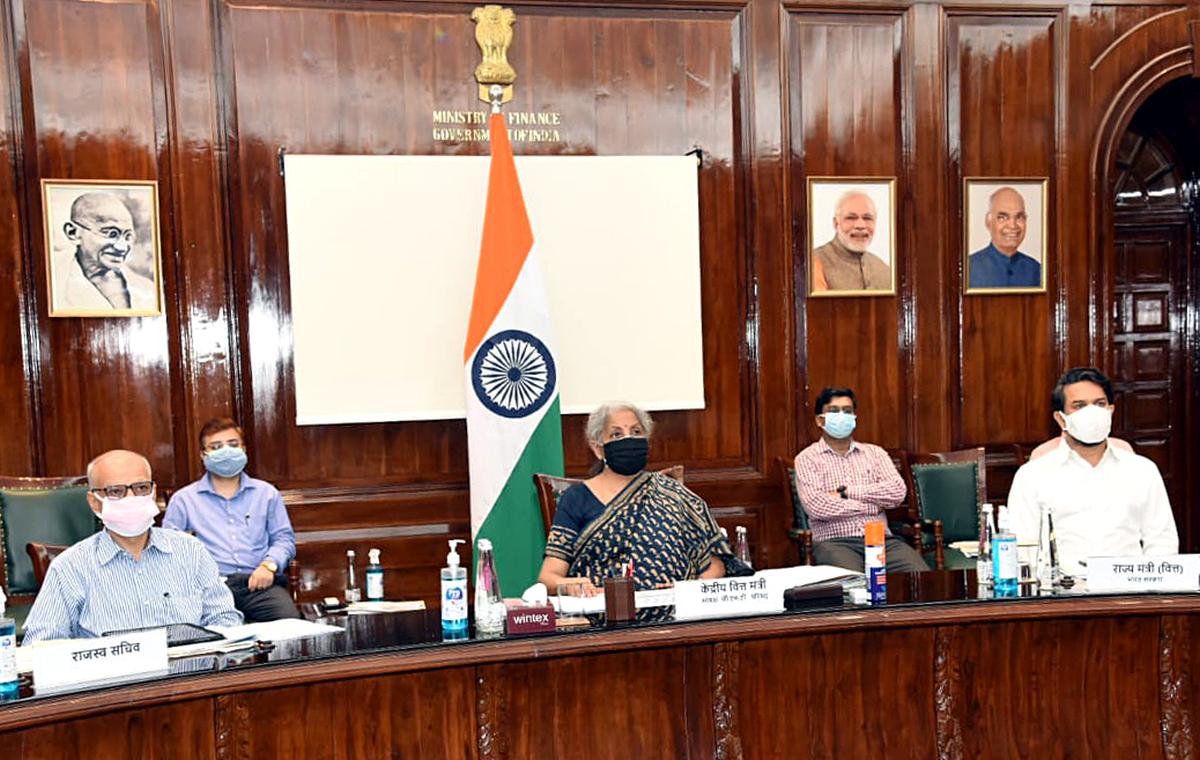Ministers’ group on GST agrees to disagree on pruning exempted items list
The GoM is likely to submit an interim report to the Council on pruning the list of items that at present do not attract the levy.
IMAGE: Finance Minister Nirmala Sitharaman chairs the 44th GST Council meet via video-conferencing in New Delhi, June 12, 2021. Photograph: ANI Photo.
A group of ministers (GoM), tasked by Goods and Services Tax (GST) Council to look into rate rationalisation, could not form a view on changes in GST rates and slabs.
However, it is likely to submit an interim report to the Council on pruning the list of items that at present do not attract the levy.
In a virtual meeting on Friday, the ministerial panel headed by Karnataka Chief Minister Basavaraj Bommai is learnt to have deliberated upon GST exemptions, rate rejig and correcting the inverted duty structure on value chains, among other matters.
“We reiterated our views on slab mergers and rationalising rate on certain products, however no conclusion has been taken,” said two of the panel members.
In the meantime, the panel will try submit an interim report to the Council before the scheduled date, they said.
According to them, the panel will be meeting again on rate restructuring.
“We are assessing the rate restructuring impact on revenue, in case the slabs are merged the slabs and the lower threshold is increased. By doing so, several aspects needs to be factored in, which could take some time,” one of the member explained.
The Council meeting is slated to be held on June 28 and 29 in Srinagar.
Business Standard had reported on June 6 that the ministerial panel, will meet ahead of the Council meeting, may defer its rate rejig agenda by a few months.
“The Council will most likely take up the suggestions of GoM on exempting goods and removing anomalies arising from taxing raw material higher than finished goods,” a government official said.
As many as 149 categories of goods and 87 services exempt from GST.
Earlier, the GoM was to consider raising the lowest threshold slab under GST to 7 or 8 per cent, from the current 5 per cent, besides changing other tax categories. Along with merging the current four slabs into three.
Currently, GST is a four-tier structure attracting tax rates of 5, 12, 18, and 28 per cent.
The slabs recast would have raised the weighted average GST rate to the revenue-neutral level of over 15 per cent, from 11 per cent at present.
The earlier two meetings were too remained inconclusive on rate rejig as GoM felt it required more deliberations, keeping in mind the prevailing high commodity prices and their impact.
Policymakers in the current circumstances too feels that it should be considered once inflation subsides.
Besides, the ministerial panel is learnt to have reviewed some suggestions of the fitment committee on the inverted duty structure particularly on textiles. However, they maintained the status quo.
An inverted duty structure arises when the GST rate for raw material is higher than that for the finished product, resulting in the accumulation of input tax credit (ITC), which affects the cash flow of companies.
Notably, last December, the Council deferred a rate hike from 5 per cent to 12 per cent on several items in the textile and apparel sector. These included woven fabrics of cotton, silk and wool, coir mats, apparel, and clothing accessories of sale value up to Rs 1,000, which was to take effect from January 1.
The Council had earlier addressed the issue of duty inversions in several items, including footwear and mobile.
For all the latest business News Click Here

